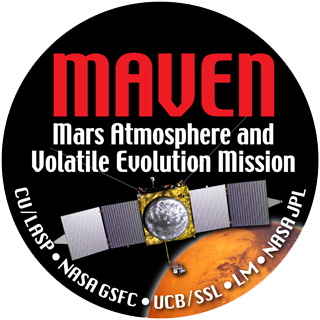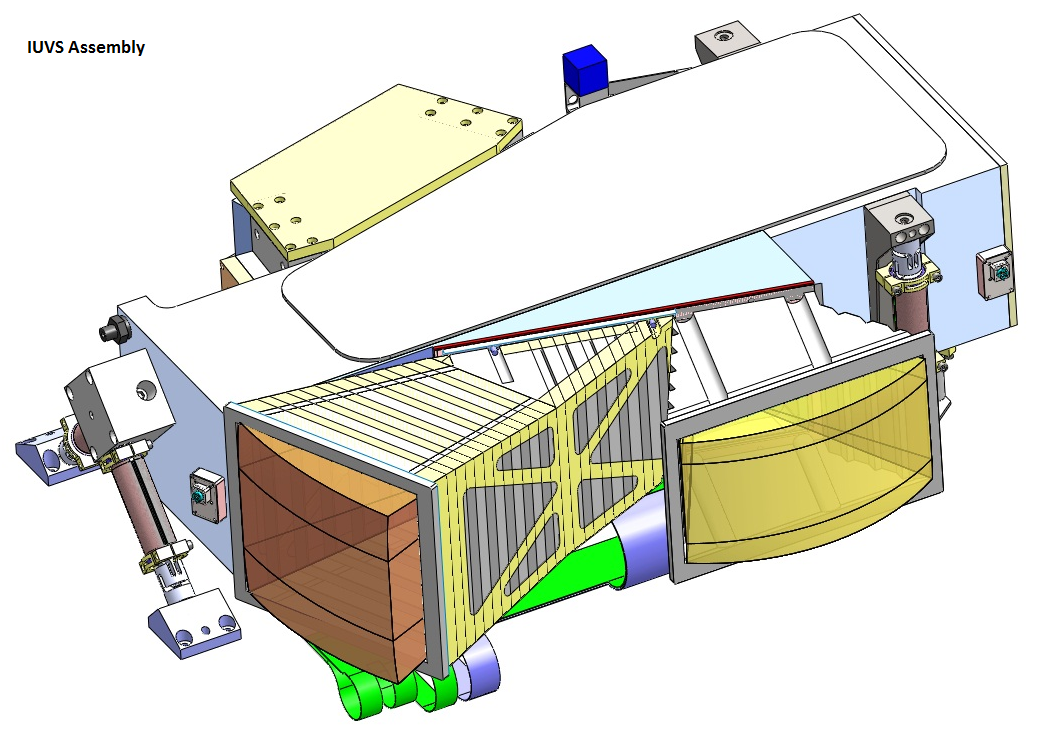- Profiles and column abundances of H, C, N, O, CO, N2, and CO2 from the homopause up to two scale heights (~1500 km for coronal H and O, ~24 km for CO2) above the exobase with a vertical resolution of one scale height for each species and 25% accuracy.
- Profiles and column abundances of C+ and CO2+, from the ionospheric main peak up to the nominal ionopause with one O2+ scale height vertical resolution and 25% accuracy.
- D/H ratio above the homopause with sufficient accuracy (~30%) to capture spatial/temporal variations (factor of 2) and compare with measured D/H in bulk atmosphere.

Currently available data extend through November 14, 2024 (Ls 1.1 MY 38)[ongoing]
(MAVEN Mars orbit insertion occurred Sep 21, 2014; Ls 199.8, MY 32)
(MAVEN Mars orbit insertion occurred Sep 21, 2014; Ls 199.8, MY 32)
IUVS is an Imaging UltraViolet Spectrograph Spanning 110-340 nm with two spectral resolution modes with low resolution (180-340 nm, λ/Δλ~400) and high resolution (110-190 nm, λ/Δλ=13,800) to measure the D/H ratio. The instrument operates in 5 modes; stellar occultation, echelle, limb, scan, disk mapping, and corona observations.
Measurement Objectives
IUVS measures vertical profiles of neutrals and ions through limb emissions and provides information on the lower atmospheric properties from stellar occultations. In addition, it provides full disk maps obtained near apoapsis as well as D/H ratios and hot coronal mapping. To contribute to the mission goals, IUVS makes 3 types of measurements:
Useful Mission Documents
Archive Bundle Contents
IUVS operates in multiple modes: limb scans, echelle mode, disk scans, coronal scans, and stellar occultations. Each readout of the detector returns data in data numbers (DN) versus wavelength and position along the aperture. The binning of the detector readouts in the spatial and spectral domains varies with operational mode. Processed and derived data products convert the DN to spectral radiance in kilorayleigh/nanometer (kr/nm) and local and volumetric densities for relevant species.
The data are separated by mode and reduction level.
Measurement Objectives
IUVS measures vertical profiles of neutrals and ions through limb emissions and provides information on the lower atmospheric properties from stellar occultations. In addition, it provides full disk maps obtained near apoapsis as well as D/H ratios and hot coronal mapping. To contribute to the mission goals, IUVS makes 3 types of measurements:
Useful Mission Documents
Mission Description
Mission Timeline (csv) can be used to select time intervals of interest. This table is constructed from parameters derived from the MAVEN SPK file. It contains times of periapse and apoapse and geometry parameters that are associated with the periapse of each orbit.
Software Interface Specification (SIS) - Description of the instrument and data structures
Mission Timeline (csv) can be used to select time intervals of interest. This table is constructed from parameters derived from the MAVEN SPK file. It contains times of periapse and apoapse and geometry parameters that are associated with the periapse of each orbit.
Software Interface Specification (SIS) - Description of the instrument and data structures
Archive Bundle Contents
IUVS operates in multiple modes: limb scans, echelle mode, disk scans, coronal scans, and stellar occultations. Each readout of the detector returns data in data numbers (DN) versus wavelength and position along the aperture. The binning of the detector readouts in the spatial and spectral domains varies with operational mode. Processed and derived data products convert the DN to spectral radiance in kilorayleigh/nanometer (kr/nm) and local and volumetric densities for relevant species.
The data are separated by mode and reduction level.
Raw = DN/bin + engineering and geometric data
Calibrated = Calibrated instrument readouts in kr/nm and ancillary data
Processed = calibrated brightness including isolating emission features and spatial binning
Derived = column abundance, density profiles, and maps ( none yet archived)
Calibrated = Calibrated instrument readouts in kr/nm and ancillary data
Processed = calibrated brightness including isolating emission features and spatial binning
Derived = column abundance, density profiles, and maps ( none yet archived)
See section 4.1 of the SIS for processing details.
Documentation - Directory containing the document collection, which includes references to refereed journals using this instrument, and information about calibration and explanation of data structures.
Key Parameters - Summary of important observed emission features and derived quantities from the nominal modes of operation (limb scans, coronal scans, echelle mode scans, disk imaging, and stellar occultations). These key parameters are condensed from more detailed high order data products.
Data:
All data are stored in Flexible Image Transport System (FITS) format with a detached PDS4 XML label (Need to acquire a FITS reader?). Data are organized by mission phase and separated into modes ( Corona, Disk, Echelle, Limb or Stellar Occultation), based on differences in processing techniques. Each mode contains Raw, Calibrated, Processed, and Derived data products. See the Software Interface Specification (SIS) Section 6.1 for details.
Calibration Information and Files
Cruise Data
Transition Data
Corona Scan
Disk Scan
Echelle Mode
Limb Scan
Stellar Occultation
Phobos
Comet C/2013 A1(Siding Spring)
Citing Data Sets for Publications
Use of Raw data
N. Schneider, N. et al., (2015), MAVEN IUVS Raw level Data Product Bundle, NASA Planetary Data System, https://doi.org/10.17189/1518929.
Use of calibrated data
N. Schneider, N. et al., (2015), MAVEN IUVS Calibrated-level Data Product Bundle, NASA Planetary Data System, https://doi.org/10.17189/1518946.
Use of processed data
N. Schneider, et al. (2015), MAVEN IUVS Processed-level Data Product Bundle, NASA Planetary Data System, https://doi.org/10.17189/1518964.
Use of derived data
N. Schneider, N. et al., (2015), MAVEN IUVS Derived-level Data Product Bundle, NASA Planetary Data System, https://doi.org/10.17189/1518956.
Other Useful Products for Interpreting the Data
References - A listing of team members to facilitate literature searches
SPICE - Archived MAVEN SPICE ancillary data providing observational geometry (positions, orientations, instrument pointing, time conversions, etc.) are available from the PDS NAIF Node.
Documentation - Directory containing the document collection, which includes references to refereed journals using this instrument, and information about calibration and explanation of data structures.
Key Parameters - Summary of important observed emission features and derived quantities from the nominal modes of operation (limb scans, coronal scans, echelle mode scans, disk imaging, and stellar occultations). These key parameters are condensed from more detailed high order data products.
Data:
All data are stored in Flexible Image Transport System (FITS) format with a detached PDS4 XML label (Need to acquire a FITS reader?). Data are organized by mission phase and separated into modes ( Corona, Disk, Echelle, Limb or Stellar Occultation), based on differences in processing techniques. Each mode contains Raw, Calibrated, Processed, and Derived data products. See the Software Interface Specification (SIS) Section 6.1 for details.
Calibration Information and Files
Cruise Data
Transition Data
Corona Scan
Disk Scan
Echelle Mode
Limb Scan
Stellar Occultation
Phobos
Comet C/2013 A1(Siding Spring)
Citing Data Sets for Publications
Use of Raw data
N. Schneider, N. et al., (2015), MAVEN IUVS Raw level Data Product Bundle, NASA Planetary Data System, https://doi.org/10.17189/1518929.
Use of calibrated data
N. Schneider, N. et al., (2015), MAVEN IUVS Calibrated-level Data Product Bundle, NASA Planetary Data System, https://doi.org/10.17189/1518946.
Use of processed data
N. Schneider, et al. (2015), MAVEN IUVS Processed-level Data Product Bundle, NASA Planetary Data System, https://doi.org/10.17189/1518964.
Use of derived data
N. Schneider, N. et al., (2015), MAVEN IUVS Derived-level Data Product Bundle, NASA Planetary Data System, https://doi.org/10.17189/1518956.
Other Useful Products for Interpreting the Data
References - A listing of team members to facilitate literature searches
SPICE - Archived MAVEN SPICE ancillary data providing observational geometry (positions, orientations, instrument pointing, time conversions, etc.) are available from the PDS NAIF Node.

 PDS: The Planetary Atmospheres Node
PDS: The Planetary Atmospheres Node



